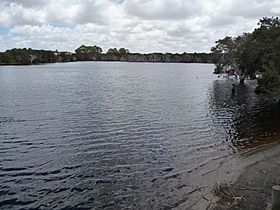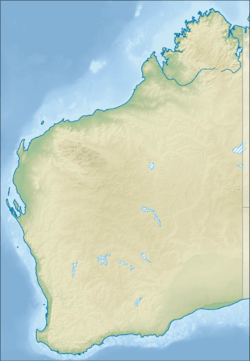Lake Monginup facts for kids
Quick facts for kids Lake Monginup |
|
|---|---|
| Lake Mongingup; Lake Mortijinup | |
 |
|
| Location | Goldfields-Esperance, Western Australia |
| Coordinates | 33°48′18″S 121°38′38″E / 33.80500°S 121.64389°E |
| Type | Freshwater |
| Primary inflows | Kateup Creek |
| Basin countries | Australia |
| Designation | Lake Monginup Nature Reserve |
| Max. length | 3.5 km (2.2 mi) |
| Max. width | 2 km (1.2 mi) |
| Surface area | 32 ha (79 acres) |
Lake Monginup, also known as Lake Mongingup and Lake Mortijinup, is a beautiful freshwater lake in the Goldfields-Esperance region of Western Australia.
This lake is located about 18 kilometers (11 miles) west of Esperance. It is a key part of the special Lake Monginup Nature Reserve. The reserve covers a large area of 102 hectares (252 acres).
Protecting Lake Monginup
The Lake Monjingup Development Committee helps manage this amazing nature reserve. In 2008, they received a grant of $32,000. This money helped them improve visitor facilities around the lake.
They also worked to protect the plants from a disease called dieback. Plus, they helped bring native mammals back into the area.
Amazing Plants and Trees
Lake Monginup Nature Reserve is a great example of untouched nature. You can find many native plants here. One very special plant is the Macrozamia dyeri. Some of these plants are over 1,000 years old! Imagine a plant that has been growing for a thousand years!
A Look Back in Time
Long ago, this area had different uses. It was once a track for motorcycles. People also used it as a market garden to grow food. Stockmen, who looked after animals, would bring their horses here for water.
In 1983, a group of local people became worried about the area. They started a campaign to protect it. This group planted over 30,000 trees! They also made the reserve bigger by adding nearby farmland. Now, there are over 14 kilometers (9 miles) of walking trails for everyone to enjoy.
Wonderful Wildlife
The Lake Monginup Nature Reserve is home to many different animals. You can find 90 species of birds living here. There are also 18 species of lizards. Plus, 9 species of frogs make their home in the reserve.
Some of the unique mammals you might spot include honey possums. You might also see echidnas and western grey kangaroos hopping around.


